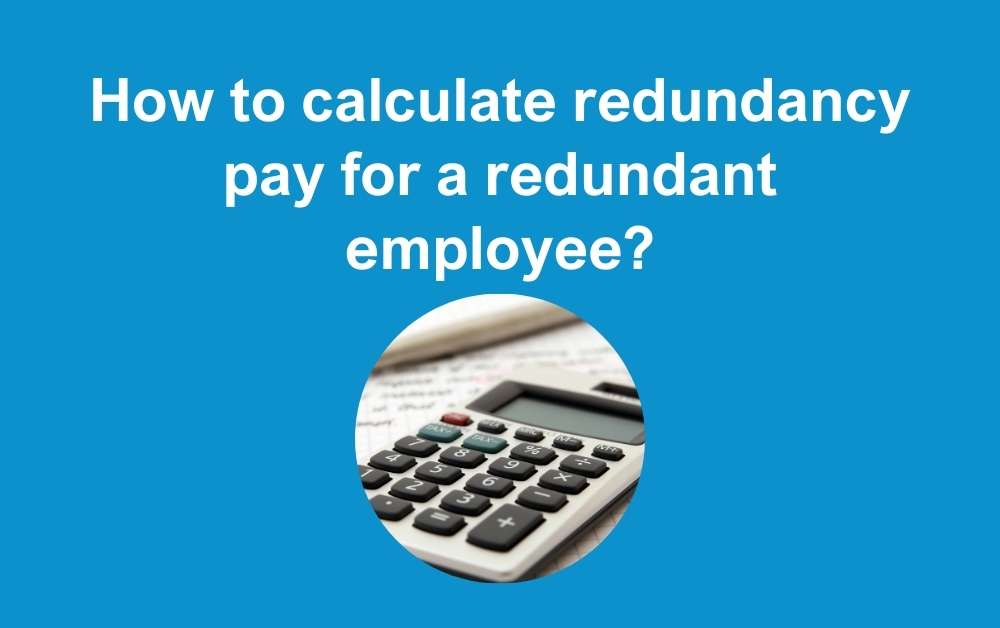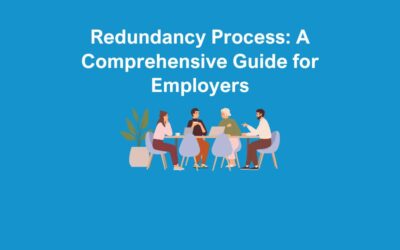If you are at the stage where you are working out how to calculate redundancy pay, you have already explored other options, followed the right redundancy process, told employees, gone through the consultations, and selected employees for redundancy. Or you may be here incase you are faced with this difficult decision in the future.
Either way, we have answered all your redundancy questions to help you avoid any mistakes.
How is Redundancy Calculated?
Your employee is entitled to statutory redundancy pay if they have been employed with you for at least 2 years. How many weeks’ pay your staff are entitled to depends on how many years they have worked for you. This is currently capped at the last 20 years they’ve worked for you. Pay also depends on age. When working out how to calculate redundancy pay, you should also be aware that:
- Staff are entitled to half a week’s pay for each full year they were under 22 years
- one week’s pay for each full year they were 22 to 40 years old
- This increases to one and a half week’s pay for each full year when they are 41 or older
Your employees weekly pay is the average they earned per week over the 12 weeks before the day they got their redundancy notice.
The current maximum statutory pay for a week is £700 and the maximum statutory redundancy pay in total is £21,000.
You can use the Government statutory redundancy calculator to find out what your employee is entitled to.
It’s also important you check contracts as it may state you need to pay enhanced or contractual redundancy pay. This must not be lower than the statutory amount.
Enhanced Redundancy Pay
Enhanced redundancy pay is when an employer pays extra money above the statutory amount staff are entitled to. In addition, when working out how to calculate redundancy pay, it’s important to check contracts and employee handbooks to see if they state anything about this.
If you find that the contractual redundancy pay is stated in contracts and handbooks, you must ensure this isn’t less than the statutory amount. You must also clarify to employees how this is calculated and when it will be paid.
Furthermore, to work this out, you must calculate the length of the statutory notice and add this to the actual leaving date.
If you would like support with this, you can contact our HR Consultants.
Contractual Notice Period
A contractual notice period is the agreed duration of notice that an employer or employee must provide before ending employment. This period is typically outlined in the employee’s contract of employment and ensures that both parties have adequate time to prepare for the termination of the working relationship. When calculating redundancy pay, the contractual notice period plays a crucial role as it affects the overall timeline of the redundancy process. Employers must honour the terms of the notice period or, alternatively, provide pay in lieu of notice (PILON) if the employee is not required to work during this time. Understanding the contractual notice period helps ensure compliance with employment laws and facilitates a smoother redundancy process.
To determine the relevant date for an employee with a contractual notice period:
- Calculate the number of weeks the statutory notice period would have been.
- Add these weeks to the employee’s actual leaving date.
This will provide the relevant date needed to calculate the employee’s length of service and determine their entitlement to redundancy pay.
Are part-time employees entitled to redundancy pay?
Yes, part-time employees are entitled to redundancy pay. This is whether they work two hours a week or 20 hours. There is no minimum requirement for working hours in this instance.
When working out how to calculate redundancy pay for a part-time employee, you must take into account their weekly pay, length of service and age. Again, you can use the redundancy calculator on the Government website to work this out.
How to calculate redundancy pay if an employee is paid in lieu of notice?
Where an employee is dismissed with a payment in lieu of notice, to calculate their length of service for the purposes of statutory redundancy pay, the employer should add on the minimum statutory notice period to the employee’s service as at the date on which the employment ends.
Furthermore, an employee’s length of service for redundancy pay purposes should be calculated as at the “relevant date”. Where an employee has been dismissed without the statutory minimum notice to which they are entitled, including where a payment is made in lieu of notice, under the Employment Rights Act the relevant date is the date on which the minimum notice would have expired had it been given.
In addition, if an employee would have reached an anniversary increasing their length of service during the statutory minimum notice period, had they not been dismissed without notice, the extra year should be included in the calculation of their redundancy payment. For example, an employee with 5 years and 11 months service is entitled to 5 weeks statutory notice period.
The maximum statutory notice period is 12 weeks. Therefore an employee with 20 years and 11 months service is entitled to the full 12 weeks. The redundancy payment for this employee will be based on 21 years of service if they are dismissed with a payment in lieu of notice because the statutory notice period of 12 weeks would give them an additional full year of service.
Overtime, bonuses and commission
An employee’s weekly pay should also account for:
- Guaranteed overtime outlined in their contract, which the employer is obliged to offer and the employee is required to work
- Any bonuses or commission payments
When to make the redundancy payment
Redundancy payments must be made no later than the employee’s final pay day, unless both parties agree in writing to a different date.
Ensure you inform employees when and how the payment will be made, such as whether it will be included in their regular monthly pay or processed as a separate payment.
Failing to pay redundancy on time could result in the employee making a claim to an employment tribunal.
Conclusion
When calculating statutory redundancy pay for your employees, you must get it right. Failure to do so can lead to an employment tribunal case. You can also read more on how to tackle redundancy in the workplace in our blog. If you would like support in calculating redundancy pay from our outsourced HR team, contact us now.
Redundancy calculators online
How to calculate redundancy payout?
First step is to ensure the employee has at least two years service with the organisation. Next, you must calculate the average weekly pay. Then you must determine redundancy pay:
- If the employee is under 22 years old – ½ a week’s pay for each year of service.
- 22 – 40 years old – 1 week’s pay for each year of service.
- 41 years or older – 1.5 week’s pay for each year of service.
After this, you should apply the weekly pay cap (this is set by the UK government). Finally, you can calculate the total redundancy pay (multiply the average weekly pay by the appropriate number of weeks based on age + years of service with the organisation).
How much redundancy for 15 years of service? (also for 5, 10, 20)
These calculations are based on the employee being between 22 and 40 at the time of the redundancy, and is based on £1000 per week (just as the example!)
5 years
- 5 years means 1 week’s pay for every year = 5 weeks’ pay.
- 5 weeks x £1000 = £5000
10 years
- 10 years means 1 week of pay for every year = 10 weeks of pay.
- 10 weeks x £1000 = £10000
- 15 years
- 15 years means 1 week of pay every year = 15 weeks.
- 15 weeks x £1000 = £15000
20 years
- 20 years means 1 week of pay for every year = 20 weeks of pay.
- 20 weeks x £1000 = £20000
Is redundancy pay based on current salary?
Redundancy pay is based on the average employee salary at that time, using their weekly salary. There is a weekly pay cap inserted as well. If an employee earns more than £643 per week, their earnings will be capped at this amount.
Is redundancy worked out on final salary?
Redundancy pay will reflect the amount you are earning at the time of redundancy. This will include aspects such as average weekly pay, upcoming bonuses and any outstanding overtime pay due.
What is the 80 rule for redundancy?
The 80 rule refers to a feature of pension agreements that enables early retirement for some employees.
There are three main factors to consider here –
The employee has to be eligible for early retirement. This often applies to employees in public sector pension schemes.
The ‘80’ part is relevant for when the employees’ age + years of service equals 80.
The benefit here for employees is that they can receive their full pension and don’t have to worry about the restrictions (such as losing out on some of your pension) associated with standard early retirement.
What are the rules regarding redundancy pay?
I have summarised the main rules of redundancy pay:
- Employees must have worked at their employers for two continuous years.
- The weekly pay cap is £643 per week. The employee cannot receive more than this (per week).
- The first £30,000 of a redundancy payment is tax-free.
- The redundancy selection process must be fair and non-discrminatory.
- Any holiday and unpaid wages must be included in the final redundancy payment.
How does redundancy pay differ for employees with less than two years of service?
Redundancy pay can vary in the following ways:
- Employees with under two years service do not receive statutory redundancy pay.
- The statutory minimum notice period for employees with less than two years service is one week.
- Employees should still receive pay for any accrued & untaken holidays and unpaid wages.
How should redundancy pay be calculated for employees with fluctuating weekly earnings?
Redundancy pay must be calculated as an average of their weekly earnings in the 12 weeks prior to the date of the redundancy notice.
How does redundancy pay calculation differ for employees on maternity leave?
Employees on maternity leave must receive equal treatment. You must base the pay off of their normal weekly earnings and not maternity pay.
How can part-time employees' redundancy pay be accurately calculated to ensure fairness?
Have a fair selection process throughout. Never discriminate or use redundancy as an ‘excuse’ to get rid of an employee.
Follow the legal guidelines throughout this blog.
Ensure you pay the right amount, excluding maternity/paternity pay. Just base the amount due off of the employees average weekly earnings.
Is redundancy pay based on current salary?
Redundancy pay is calculated from the employee’s average weekly earnings. Either their weekly earnings are a fixed rate or a variable rate. If it is the latter, then you should work out the average weekly earnings from the last 12 weeks prior to the redundancy notice.
How is redundancy usually worked out?
Multiply the average weekly pay by the appropriate number of weeks based on age + years of service with the organisation.
Redundancy over 60 years old
Redundancy pay calculations are split into three different categories. Under 22, 22 – 40 & 41 older.
For someone who is 41 years or older, they receive 1.5 weeks of pay for each full year of service they have given to that game.
Is redundancy pay taxable
Redundancy fees up to £30,000 are tax – free. Any amount over the £30,000 will be taxed as per the UK income tax regulations.
What is statutory redundancy pay
Statutory redundancy pay is a payment for an employee who is being made redundant. This employee must meet certain criteria such as having at least two years of service with the organisation.
What is the Redundancy notice in the UK
The statutory redundancy notice period is relevant to the length of service that employee has with the organisation.
Less than 1 month of service, there is no statutory notice. With 1 month to 2 years of service, this will require 1 week’s notice. Between 2 and 12 years, this is 1 week’s notice for each year of service. 12 years or more service requires 12 week’s notice.
What steps should an employer take before calculating redundancy pay?
The main steps to take here are:
- Speak with your employees and aim for transparency. In addition, if this situation involves 20+ employees, then start a legal consultation.
- Calculate statutory redundancy pay – include age, duration of employment and salary.
- Look at alternative options such as part-time work, job sharing or overtime ban.
Are there any exceptions to the statutory redundancy pay calculations?
There are several exceptions to statutory redundancy pay calculations, such as:
- Employees who have under two years service.
- Employees who have been dismissed under grounds of gross misconduct.
- Crown servants and armed services are excluded too.
What is the process for handling enhanced or contractual redundancy pay?
The following steps should be followed:
- Review any employee contracts that will include specific redundancy terms.
- Communicate this to employees, note every communication down in your records
- Calculate the pay
- Confirm any communication in writing and make the payment
What legal considerations should employers be aware of when calculating redundancy pay?
There are various legal considerations to remember. One of which is to ensure that the redundancy pay you are offering is at least the minimum, based on the employees’ service length, age and weekly pay.
Employees with 2 or more years service are the only employees who should be considered. Make sure you have the exact details of the employees’ length of service.
Redundancy pay must be calculated as an average of their weekly earnings in the 12 weeks prior to the date of the redundancy notice.
What are the common mistakes employers make when calculating redundancy pay?
Some common mistakes on calculations surrounding redundancy pay include:
- Miscalculation of earnings – an example here includes using maternity/paternity pay instead of normal earnings.
- Delayed payments – payments may be late, which is a breach of the legal conditions surrounding redundancy pay.
- Bad treatment of employees – aim to be transparent throughout this difficult process. If employees’ wellbeing is neglected, then this can spread by word of mouth to other people. A bad reputation can have a knock-on effect for years to come.
How can employers ensure they are compliant with redundancy pay regulations?
- Ensure that you know the legal requirements. We (The HR Booth) can help support you on this.
- Have a fair selection process, avoiding discrimination at all stages.
- Keep a record/notes of every communication with employees. Aim for transparency all throughout.
Hold regular training sessions with your staff. We (The HR Booth) offer training sessions and workplace management.



